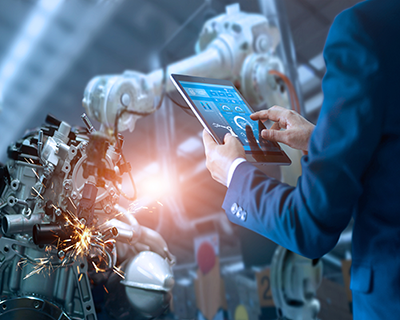AuraQ has vast experience helping organisations find the gaps that can be filled to enhance their business. This could be to improve efficiency, integrate legacy systems or deliver new portals and strategic applications to create competitive advantage. Contact us to request a free, no obligation Gap Analysis.
Top 5 trends in intelligent automation
Businesses are racing to drive Return on Investment (ROI) as they bounce back post-pandemic and most are leading these efforts through effective digital transformation. This paves the way for a year of Intelligent Automation (IA), but what trends will we see?
1 Chatbots to increase in popularity
Offering the advantages of 24/7 availability and zero wait times, chatbots have been gaining popularity. Far from outdated and inefficient bots of yesterday, today’s chatbots are much smoother and effective in aiding workers eliminate the cumbersome and repetitive queries so they can focus on results-based work. With global business ecosystems diversifying, geographical changes can also be aided through chatbots, as they allow business to operate from anywhere. Additionally, intelligent chatbots will be able to eliminate errors in understanding and boost productivity. Chatbots for customer support are already prevalent and due to become embedded in the mainstream in 2022, driven by greater digitisation and business customer interaction moving online. They are also increasingly used to complete sales and applications for services.
2 Artificial Intelligence (AI) driving intelligent automation
At a crossroads of the next wave of technology, we find ourselves witnessing a digital transformation evolving from legacy Robotic Process Automation (RPA) to Intelligent Automation. With businesses across the globe relying extensively on cloud computing to maintain business continuity over the last two years, legacy RPA will need to become more intelligent with the help of AI driven intelligent automation. Combining RPA with AI, machine learning, and natural language processing from the first moment of development is the next step to turn task-based automation into Intelligent Automation, enabling information on how processes need to be redefined, saving time on human analysis, and speeding up these processes. AI will provide automated processes the necessary intelligence to grow and learn, performing tasks such as identifying trends and insights around changing customer behaviour, and predicting future stock supply needs. This will boost overall customer experience and satisfaction.
3 Process mining to become more closely integrated with RPA
Process mining is when all business process analysis is enabled automatically with all relevant steps in the process, even those which are not obvious to humans based on digital traces in IT systems. Unsurprisingly, the process analytics market size is expected to grow to $1.4 billion globally by 2023. Process mining will increasingly become more closely integrated with Robotic Process Automation (RPA) to enable the analysis of many granular process steps, providing automation projects with the necessary data basis for dynamic RPA solutions. In addition, the combination of process mining and low-code platforms will continue to enter the market, to be used to show not only what is failing, but also what needs to be done to improve any enterprise situation, reducing time and costs wasted on making unnecessary changes. This demand is set to grow based on the fact that change, enabled from these technologies, will be happening at a much quicker rate than ever before.
4 No coder? No problem
Low-code and no-code automation are on the rise, allowing for the automating of important business processes that will require little coding, making it easier for non-technical employees to implement automation functions into the business. AI has long required specialised expertise, but with the better accessibility of no-code and low-code, platforms will allow the end-user to dictate the automation process design through simple drag and drop manipulation. This will enable a wider range of employees to build powerful AI models that can help boost intelligent automation, letting the coding experts focus on more pressing tasks to innovate further and drive company growth.
5 No more “the Robots are going to take your job” rhetoric
While talk of robots ‘taking jobs’ drives sensationalist headlines, it isn’t based in fact. Robotic Process Automation (RPA), especially when combined with AI, removes mundane, tedious admin tasks, allowing people to take on tasks that empower them, those requiring creativity, critical thinking and emotional intelligence. The World Economic Forum predicts automation will result in a net increase of 58 million jobs. Automation will undoubtedly change the nature of modern work, and reskilling will be needed, as it was during the industrial revolution. But to suggest that this will make our working lives worse or lead to mass unemployment is far from the truth. 2022 will see a shift in workers realising the benefits they could reap if they embraced automation, and an increase in retraining and reinvesting in talent.
Looking ahead
Many businesses are already running temporary blended or hybrid models, to which automation will continue to play a key role. Capitalising on these trends in automation will see huge waves made in today’s economy, as it can reduce work, which in turn reduces costs, whilst simultaneously enabling new products and services to be developed to improve the overall customer experience. Whichever use of intelligent automation is implemented, it will benefit all within the business ecosystem, creating an effortless experience for everyone.










